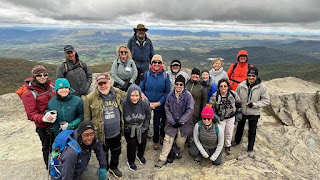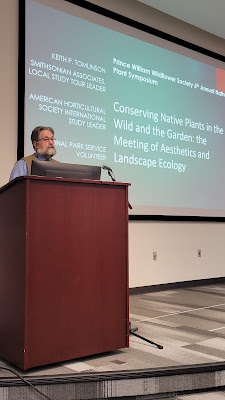On Saturday
February 11th I delivered the keynote talk at the Prince William Wildflower Society
6th Annual Symposium. This was an honor and great opportunity to
discuss one of my favorite subjects about mixing garden aesthetics with a
further understanding of landscape ecology. Many vocational gardeners, even
relatively sophisticated native plant gardeners, don't have a grasp of
landscape ecology as a basic tenant of supporting conservation in the garden
and in the wild.
Reflecting my own interest, I discussed the origins of our native
plants from preglacial Tertiary Forest distribution, Pleistocene glaciation and
postglacial forest migration from southern refugia in peninsular Florida and
southeastern North America. Through this approach I hope to enhance the general
knowledge of native plant gardeners and encourage them to consider a holistic
approach to the landscape through the increased understanding of paleoecology
and modern landscape ecology.
Landscape ecology is the science of studying and improving
relationships between ecological processes in the environment and particular
ecosystems. This is done within a variety of landscape scales including
biogeography, ecoregions, historical geology, climate and continually emerging
conservation issues.
Concisely, landscape ecology can be described as the science of
landscape diversity as the synergetic result of biodiversity and geodiversity.
In addition, I introduced the concept of Ecoregions. Ecoregions
cover relatively large areas of land or water, and contain characteristic,
geographically distinct assemblages of natural communities and species. The
biodiversity of flora, fauna and ecosystems that characterize an ecoregion
tends to be distinct from that of other ecoregions. Think the Adirondacks, Everglades, the
Sonoran Desert, Ozark Mountains or Great Lakes forests. Currently there
are 115 major ecoregions described in North America. Every single one is unique
and can be on display by landscaping with native plants. Embracing your
ecoregion is fostering a sense of place that makes gardens truly unique while
increasing environmental and aesthetic quality.

The following terms are used routinely in the presentation in hopes of
profiling both Landscape Ecology and Ecoregions.
Floristic- what plants grow where and why
Ecology- Interrelationships of organisms including biotic and abiotic factors
Biogeography- spatial distribution of organisms or biomes
Ecoregions- include geology, landforms, soils, vegetation, climate, land use,
wildlife, and hydrology.
Geomorphology- evolution of landforms/topography
Endemic- small range of distribution, common in island floras
Indigenous- native but with a wider geographic range.
The mid-section of the presentation profiles 25 plants that are unique
or nearly unique to the Mid-Atlantic region. This is based in part on the seminal
book Floristic Regions of the World by Armen Takhtajan. Takhtajan describes a “Floristic
Geography” denoting species that are particularly characteristic of the floristic
regions around the world. Predictably the endemic kingdoms of Hawaii, New
Caledonia the Cape province of South Africa and Canary Islands get a great deal
of attention. But, cosmopolitan continental floras also reveal a great deal of variety,
not so focused on endemism but based on plant diversity due to complex past
migrations and ecoregion distribution.
.jpg)
The last portion of this presentation addresses coalescing environmental
issues that are actively effecting our local and global environment.
Predictably, we discuss climate change and look at possible scenarios for the
mid-Atlantic region where warmer, wetter conditions are expected- punctuated by
occasional droughts. Fall of 2023 was an excellent example of regional drought
complete with local forest fires, mainly in the mountains. We look at plants we
can now grow including Musa basjoo the banana native to Southern Japan. In addition, we discuss the proliferation of various invasive species including naturalized, adventive and introduced.
I also cover rapidly emerging advances in genetic technology. Twenty
years ago, I coined the term MGR for the Molecular Genetic Revolution with Smithsonian
Groups, mainly borne out of new cloning technology. This has now been eclipsed by
CRISPR (Clustered Regularly Interspaced Palindromic Repeats). The current focus of CRISPR
is on various exciting medical applications. In particular, Cystic Fibrosus and
Sickle Cell Anemia among other maladies. I suggest this technology will find
application in the vast world of plant biology and have influence on both crop
production and conservation issues.
Over the past few years work on the American Chestnut has largely
abandoned breeding efforts with the Chinese Chestnut in favor of a tree altered
with CRISPR technology. Thus, a non-crop genetically modified organism (GMO)
focused on conservation and restoration is being planted widely in the
Northeastern United States. This is not without controversy, but recently the
Sierra Club endorsed the effort.
Beyond bringing back near-extinct species, I posit a different, yet
unanswered question. Is it possible CRISPR could be used to alter the
reproductive cycle of various invasive weeds. Could Japanese Knotweed or Stilt
Grass be modified to become sterile and simply fade away over time?
My hope is to encourage planting of regional native species everywhere,
not just gardens but commercial landscapes, city centers and elsewhere. This
relates directly to Doug Tallamy’s focus on food webs in native vegetation and
insect diversity that underlies the ecosystems we depend on. Spanning the
natural history of our native forests in combination with ecoregions, landscape
ecology and geomorphic phenomena I hope to foster a deeper appreciation of our
native flora. Closing with the questions of climate change and genetic advances
should further illustrate the dynamic environmental continuum we are living in- the soon to be coined the Anthropocene.






.jpg)




